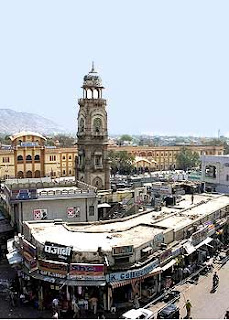AJMER-अजमेर
TEMPLES
Ajmer-e-Sharief Dargah - At the foot of a barren hill, is situated India s most important pilgrimage center for people from all faiths. It is the splendid tomb of the Sufi saint Khawaja Moinuddin Chisti more popularly known as Khawaja Saheb or Khawaja Sharif. The shrine is next only to Mecca or Median for the Muslims of South Asia. Emperor Akbar used to make a pilgrimage to this Dargah from Agra once a year.
Adhai-Din-Ka Jhonpara - One of the finest examples of Indo-Islamic architecture, this mosque was a Sanskrit college in the 12th century. In 1193 AD Mohammad Ghori destroyed the college and a mosque was built in its place. The mosque is built on pillars and surprisingly no two pillars are alike. The
archways are finely engraved with Kufi and Jughra inscriptions from the Holy Quran (also spelt as Koran).
Nasiyan (Jain Temple) - This red coloured Jain temple was built in the late 19th century. The wooden gilt in the double storeyed hall depicts scenes from the Jain mythology. The beauty of this temple is widely acclaimed. MUSEUMSGovt. Museum - The Royal palace of Akbar was converted into a museum and today it houses a rich collection of Mughal and Rajput armoury. Some of the fine and delicate sculptures of the region have been displayed here. The building itself has been constructed of red sandstone, which have been laid down in a square pattern giving it a fabulous look.
LAKES
Ana Sagar Lake - This lake was built by Anaji during 1135-1150 AD. Later the Mughal Emperors made additional constructions to beautify the lake. The 'Baradari', a marble pavilion was built by Shah Jahan and the Daulat Bagh Gardens were laid by Jehangir. This lake is located towards the north of Ajmer city.
Foy Sagar - This artificial lake was built during a famine relief programme. Named after the engineer responsible for its construction, the picturesque lake is 5-km from Ajmer
FORTS
Taragarh Fort - Built in the 7th century by Ajaipal Chauhan, the fort gives a bird's eye view of the city. Taragarh Fort, seat of the Chauhan rulers, is claimed to be the first hill fort of Asia, built at a time when the Aravalli mountain ranges were above the snowlines. This gives it the reputation of being one of the oldest hill forts of the world, and it is definitely the oldest among the hill forts in India.
Magazine - the city's Museum, was once the residence of Prince Salim, son of Emperor Akbar, and presently houses a collection of the Mughal and Rajput armour and sculpture.This residence of Salim is significant from a historical point of view, because Salim as Emperor Jahangir read out the firman for trade to India to the British East India company from here, thus starting the chain of events that lead to India's colonisation by the British
OTHERS
Mayo College - a boarding school founded by the British Raj in 1870 to educate the children of Rajputana's nobles on the lines of an English public school. Also home to the prestigious Sophia Girls' School (now College), and the historic Ajmer Music College, founded in 1942, the first accredited institution in Rajputana for teaching classical Hindustani music. One of the four NCERT Demonstration Schools of India is also located in Ajmer.


No comments:
Post a Comment